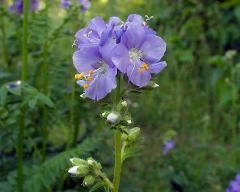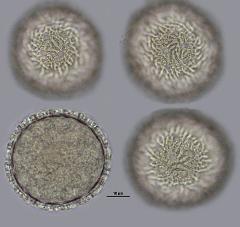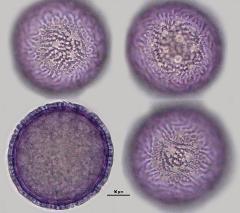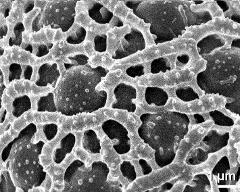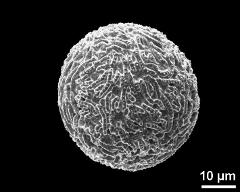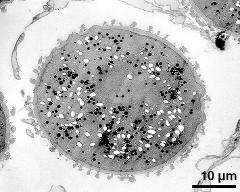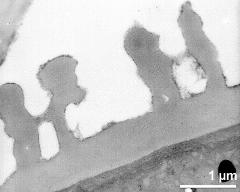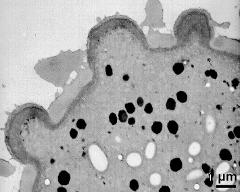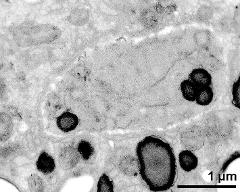Polemonium caeruleum
Taxonomy: Angiospermae, Ericales, Polemoniaceae, Polemonium
Links: http://flora.nhm-wien.ac.at/Seiten-Arten/Polemonium-caeruleum.htm
Published: 2020-12-14
Pollen Description
Shape, Size and Aperture
pollen unit: monad, dispersal unit and peculiarities: monad, size (pollen unit): medium-sized (26-50 µm), size of hydrated pollen (LM): 41-50 µm, shortest polar axis in equatorial view (LM): -, longest polar axis in equatorial view (LM): -, shortest diameter in equatorial or polar view (LM): 41-50 µm, longest diameter in equatorial or polar view (LM): 41-50 µm, pollen class: porate, polarity: isopolar, P/E-ratio: isodiametric, shape: spheroidal, outline in polar view: circular, dominant orientation (LM): polar, P/E-ratio (dry pollen): -, shape (dry pollen): spheroidal, outline in polar view (dry pollen): circular, infoldings (dry pollen): not infolded, aperture number: >6, aperture type: porus, aperture condition: pantoporate, porate, aperture peculiarities: aperture membrane ornamented, pantoaperturate
Ornamentation and Structure
LM ornamentation LM: striate, rugulate, nexine: -, sexine: -, SEM ornamentation SEM: microechinate, striato-reticulate, suprasculpture SEM: -, TEM tectum: semitectate, infratectum: columellate, foot layer: continuous, endexine: absent, intine: monolayered, wall peculiarities: -, supratectal element: -
Miscellaneous
pollen coatings: pollenkitt, reserves in cytoplasm: lipids, starch, cell number: -, Ubisch bodies: absent
Author(s) of diagnosis: Svojtka, Matthias; Heigl, Helmut
Pictures
Picture legend
- flower(s), photographer: Halbritter, H.
- hydrated pollen - fresh, glycerine, unstained, photographer: Heigl, H.
- hydrated pollen - fresh, glycerine, ruthenium red, photographer: Heigl, H.
- hydrated pollen - fresh, glycerine, ruthenium red, photographer: Heigl, H.
- hydrated pollen grain - fresh, rehydrated (water) & critical point dried & sputter coated with gold, photographer: Svojtka, M.
- exine surface - fresh, rehydrated (water) & critical point dried & sputter coated with gold, photographer: Svojtka, M.
- dry pollen grain - dry, sputter coated with gold, photographer: Svojtka, M.
- exine surface of dry pollen grain - dry, sputter coated with gold, photographer: Svojtka, M.
- cross section of pollen grain - fresh, glutaraldehyde & osmium & potassium ferrocyanide, uranyl acetate & lead citrate, photographer: Svojtka, M.
- pollen wall - fresh, glutaraldehyde & osmium & potassium ferrocyanide, uranyl acetate & lead citrate, photographer: Svojtka, M.
- detail of pollen wall - fresh, glutaraldehyde & osmium & potassium ferrocyanide, uranyl acetate & lead citrate, photographer: Svojtka, M.
- apertures - fresh, glutaraldehyde & osmium & potassium ferrocyanide, uranyl acetate & lead citrate, photographer: Svojtka, M.
- generative cell - fresh, glutaraldehyde & osmium & potassium ferrocyanide, modified Thiéry-test, photographer: Svojtka, M.
Literature
- (1998) Preparing living pollen material for scanning electron microscopy using 2,2-dimethoxypropane (DMP) and criticalpoint drying. Biotechnic Histochem 73: 137–143
Copyright and Citation
Cite this publication as:
Svojtka M., Heigl H., Halbritter H. 2020. Polemonium caeruleum. In: PalDat - A palynological database. https://pc8.botanik.univie.ac.at/pub/Polemonium_caeruleum/304371; accessed 2025-04-28

